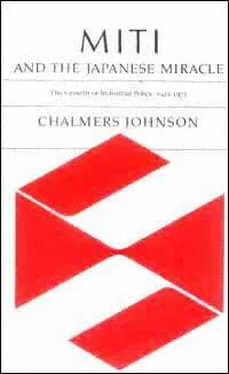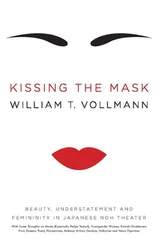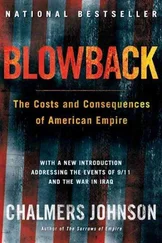Chalmers Johnson - MITI and the Japanese miracle
Здесь есть возможность читать онлайн «Chalmers Johnson - MITI and the Japanese miracle» весь текст электронной книги совершенно бесплатно (целиком полную версию без сокращений). В некоторых случаях можно слушать аудио, скачать через торрент в формате fb2 и присутствует краткое содержание. Год выпуска: 2007, Издательство: Stanford University Press, Жанр: Старинная литература, на английском языке. Описание произведения, (предисловие) а так же отзывы посетителей доступны на портале библиотеки ЛибКат.
- Название:MITI and the Japanese miracle
- Автор:
- Издательство:Stanford University Press
- Жанр:
- Год:2007
- ISBN:нет данных
- Рейтинг книги:3 / 5. Голосов: 1
-
Избранное:Добавить в избранное
- Отзывы:
-
Ваша оценка:
- 60
- 1
- 2
- 3
- 4
- 5
MITI and the Japanese miracle: краткое содержание, описание и аннотация
Предлагаем к чтению аннотацию, описание, краткое содержание или предисловие (зависит от того, что написал сам автор книги «MITI and the Japanese miracle»). Если вы не нашли необходимую информацию о книге — напишите в комментариях, мы постараемся отыскать её.
MITI and the Japanese miracle — читать онлайн бесплатно полную книгу (весь текст) целиком
Ниже представлен текст книги, разбитый по страницам. Система сохранения места последней прочитанной страницы, позволяет с удобством читать онлайн бесплатно книгу «MITI and the Japanese miracle», без необходимости каждый раз заново искать на чём Вы остановились. Поставьте закладку, и сможете в любой момент перейти на страницу, на которой закончили чтение.
Интервал:
Закладка:
burakumin
, a dispossessed minority in Japanese society.)
Nixon thought he could arrange a quid pro quo since Prime Minister Sato * had made a major political issue out of the return of Okinawa. At the Sato-Nixon* summit conference in Washington (November 1920, 1969) Nixon agreed to the precise terms Sato wanted for the return of Okinawa (without nuclear weapons), in return for which he thought he had received a promise from Sato to bring synthetic textile exports under control. The Japanese press also thought so, since it invented the slogan
ito o utte, nawa o katta
("selling thread to buy rope," meaning "trading textiles for Oki
nawa
") to characterize Sato's* diplomacy toward the United States.
16
Sato, as it turned out, could not deliver on his promise because of obstruction by both the textile industry and MITI. From September 15 to 19, 1969, a MITI on-site inspection team had toured the United States to determine the extent, if any, of damage to domestic spinners and weavers from Japanese imports. Led by Takahashi Shukuro*, the chief of MITI's Textiles Bureau, and composed of the chiefs of the First Market Section, the Fibers and Spinning Section, the Textiles Export Section, and other officials, this mission concluded that the American textile industry was thriving and that the damage caused by imports was nil. For all practical purposes this remained the Japanese position for the next two yearsthrough what was to become one of the most unproductive interactions between two allies in the postwar world, what Maeda Yasuyuki would later characterize as the "quagmire negotiations."
17
The textile dispute between Japan and the United States was only the most public and the noisiest of several economic clashes. Many of the other disputes, like that concerning textiles, also seemed to focus on MITI as the culprit. For example, following capital liberalization, MITI received a proposal from the Texas Instruments Company, which wanted to open a wholly owned subsidiary in Japan to man-
Page 286
ufacture integrated circuits. MITI sat on the proposal for some 30 months, claiming that it was giving the request "careful consideration." It then decided that the U.S. company would be permitted no more than a 50 percent ownership in conjunction with Japanese interests, that it would have to license its technology to Japanese competitors, and that it would have to limit its output until Japanese companies were better able to compete.
18
Similarly, at the time of the reversion of Okinawa, the Gulf Oil Company proposed building a refinery in Okinawa as a way of gaining access to the Japanese retail market. MITI said Gulf could not do so unless it had a Japanese partner, and when it looked as if Gulf might link up with Idemitsu Petroleum, MITI warned Idemitsu off.
19
Other issues included television exports (on June 9, 1970, Zenith charged that the Japanese were dumping TV sets in the United States, and MITI Minister Miyazawa Kiichi all but conceded the point by acknowledging that Japanese television receivers cost more in Japan than outside the country), grapefruit imports (during December 1968, the United States asked for liberalization of imports of grapefruit, tomatoes, ham, sausage, beef, and other agricultural products, but the Agriculture Ministry took a page out of MITI's book and refused), and above all joint ventures in the automobile industry.
20
With the hindsight of a decade the automobile controversy of the late 1960's seems almost laughable (during 1979 Japan sent 2.1 million cars to the United States, while the United States sent 16,224 to Japan).
21
Realistically, the issue was never one of imports of American automobiles: American manufacturers made no effort to develop models that would appeal to the Japanese market, the Japanese tariffs were too high, and American cars were too big and too expensive to operate in Japan. The issue was the desire of the American Big Three auto firms to buy into Japanese automotive companies as part of their global manufacturing and marketing strategies. Throughout late 1967 and 1968, following the first round of capital liberalization, executives of Ford, General Motors, and Chrysler were in Japan seeing whether they could find partners for joint ventures. Meanwhile, MITI was doing its best to merge the smaller auto firms into keiretsu built around either Nissan or Toyota. As we saw in the last chapter, Sahashi had already succeeded in merging Nissan and Prince, and MITI was now extracting promises from all the other producers not to contemplate joint ventures with the Americans unless they first talked it over with the ministry. Just to make sure that nothing went wrong, MITI also mobilized its amakudari network in the auto industry: Yamamoto
Page 287
Shigenobu at Toyota, Yamazaki Ryuzo * (a former chief of the International Trade Bureau) at Nissan, Suganami Shoji* (a former chief of the Commercial Affairs Bureau of MCI) at Hino, and several others.
Unfortunately for MITI, however, it had no "old boy" contact at Mitsubishi Motors (Mitsubishi Heavy Industries before June 1, 1970) for the simple reason that Mitsubishi, of all the old zaibatsu, was the most rigorous in excluding former bureaucrats from its ranks (with one or two exceptions in Mitsubishi Trading). Moreover, as the largest and most distinguished keiretsu in the country, Mitsubishi was definitely displeased by MITI's policy of building only two auto empires, Toyota and Nissan, which left it out of this business. Mitsubishi was also less fearful of foreigners than were the trade and industry bureaucrats: Mitsubishi Petroleum had long been associated with Getty Oil; the keiretsu had entered into numerous joint ventures (Caterpillar Mitsubishi, Mitsubishi-York, Mitsubishi-TRW, Mitsubishi-Mallory, Mitsubishi-Monsanto, and so forth); and, given Mitsubishi's huge financial resources, the Japanese side in any auto deal was more likely to buy out its foreign partner than the other way around.
The stage was thus set for the biggest shock MITI ever received in its history, the announcement of May 12, 1969, that Vice-President Makita Yoichiro* of Mitsubishi Heavy Industries had returned from Detroit with an agreement with Chrysler to create a new automobile company (Mitsubishi would contribute an initial capital of ¥46 billion, or 65 percent, and Chrysler ¥16.1 billion, or 35 percent). Yoshimitsu Hisashi, the incumbent chief of the Heavy Industries Bureau, said that the announcement hit him like water poured into his ear while he was sleeping (
nemimi ni mizu da
, that is, like a "bolt from the blue"), and Vice-Minister Kumagai declared himself appalled.
22
The fallout from the Mitsubishi-Chrysler agreement was enormous. The politicians and the businessmen immediately read it as a declaration of independence by some big businessmen from MITI. On October 14, 1969, the cabinet decided to speed up the liberalization of automotive capital, now scheduling it for October 1971. The government would not approve the Mitsubishi-Chrysler deal until that time, but when the time arrived it could stall no longer. During the autumn of 1969 Mitsubishi opened assembly lines for a car called the "Colt Gallant Hardtop," which it proudly showed off to Chrysler distributors who visited Japan as a delegation during EXPO 70, the big international exposition sponsored by MITI. As soon as the date for liberalization had passed, the joint venture was put into effect and Chrysler began to sell the Mitsubishi car in the United States as the
Page 288
"Dodge Colt." As a result Mitsubishi promptly moved ahead of Toyo * Kogyo* to become Japan's number three automaker (and, as it turned out a decade later, when the U.S. number three auto manufacturer had to seek governmental assistance to stay in business, the most profitable division of Chrysler).
Читать дальшеИнтервал:
Закладка:
Похожие книги на «MITI and the Japanese miracle»
Представляем Вашему вниманию похожие книги на «MITI and the Japanese miracle» списком для выбора. Мы отобрали схожую по названию и смыслу литературу в надежде предоставить читателям больше вариантов отыскать новые, интересные, ещё непрочитанные произведения.
Обсуждение, отзывы о книге «MITI and the Japanese miracle» и просто собственные мнения читателей. Оставьте ваши комментарии, напишите, что Вы думаете о произведении, его смысле или главных героях. Укажите что конкретно понравилось, а что нет, и почему Вы так считаете.












